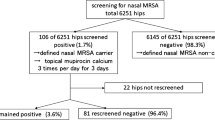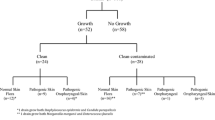Abstract
Purpose
MRSA is an organism that is a possible risk factor for postoperative SSI. The purpose of the study was to examine relationships among surgical site infection (SSI) after spinal surgery, nasal methicillin-resistant staphylococcus aureus (MRSA) colonization, and wound drain culture results.
Methods
The subjects were 132 patients who underwent spinal instrumentation surgery. A preoperative nasal swab was used to check for the presence of MRSA colonization, and a wound drain tip culture was performed for detection of SSI. Data from culture studies using nasal samples and those from the distal tip of the wound drain were used for analysis.
Results
Five patients (3.8%) had nasal MRSA, 17 (13%) had positive drain tip cultures, 15 (11%) had SSIs, and 10 (8%) had SSIs with MRSA. Patients with nasal MRSA had a higher rate of detection of bacteria in the drain tip culture (40 vs. 19%, p = 0.065), and the SSI rate was significantly higher in patients with a positive drain tip culture (33 vs. 10%, p = 0.012). The total SSI rate differed significantly between patients with and without nasal MRSA (40 vs. 10%, p = 0.039); however, the SSI with MRSA rate did not differ significantly between these groups.
Conclusion
MRSA carriers were not necessarily associated with MRSA infection, but were related to a positive drain tip culture and SSI, which might be due to endogenous skin bacteria. Therefore, possible SSI should be considered in patients with nasal MRSA colonization or bacteria detected in a drain tip culture.
Similar content being viewed by others
References
Wertheim HF, Melles DC, Vos MC et al (2005) The role of nasal carriage in Staphylococcus aureus infections. Lancet Infect Dis 5:751–762
Bode LG, Kluytmans JA, Wertheim HF et al (2010) Preventing surgical-site infections in nasal carriers of Staphylococcus aureus. N Engl J Med 362:9–17
Thakkar V, Ghobrial GM, Maulucci CM et al (2014) Nasal MRSA colonization: impact on surgical site infection following spine surgery. Clin Neurol Neurosurg 125:94–97
Costantini ST, Lach D, Goldfarb J et al (2013) Staphylococcus aureus colonization in children undergoing heart surgery. World J Pediatr Congenit Heart Surg 4:267–270
Chen AF, Heyl AE, Xu PZ et al (2013) Preoperative decolonization effective at reducing staphylococcal colonization in total joint arthroplasty patients. J Arthroplast 28:18–20
Takahashi Y, Takesue Y, Uchino M et al (2014) Value of pre- and postoperative meticillin-resistant Staphylococcus aureus screening in patients undergoing gastroenterological surgery. J Hosp Infect 87:92–97
Ramirez MC, Marchessault M, Govednik-Horny C et al (2013) The impact of MRSA colonization on surgical site infection following major gastrointestinal surgery. J Gastrointest Surg 17:144–152
Savage JW, Anderson PA (2013) An update on modifiable factors to reduce the risk of surgical site infections. Spine J 13:1017–1029
Kanazawa A, Yamazaki T, Murakami M (2014) Correlation between nasal, skin bacterial carriage and surgical site infection in spinal operation. Seikeigeka 65:447–449
Mest DR, Wong DH, Shimoda KJ et al (1994) Nasal colonization with methicillin-resistant Staphylococcus aureus on admission to the surgical intensive care unit increases the risk of infection. Anesth Analg 78:644–650
Kobayashi K, Imagama S, Ito Z et al (2017) Is a drain tip culture required after spinal surgery? Clin Spine Surg 30:356–359
Huang SS, Septimus E, Kleinman K et al (2013) Targeted versus universal decolonization to prevent ICU infection. N Engl J Med 368:2255–2265
Wendt C, Schinke S, Württemberger M et al (2007) Value of whole-body washing with chlorhexidine for the eradication of methicillin-resistant Staphylococcus aureus: a randomized, placebo-controlled, double-blind clinical trial. Infect Control Hosp Epidemiol 28:1036–1043
Mangram AJ, Horan TC, Pearson ML et al (1999) Guideline for Prevention of Surgical Site Infection, 1999. Centers for Disease Control and Prevention (CDC) Hospital Infection Control Practices Advisory Committee. Am J Infect Control 27:97–132
Yano K, Minoda Y, Sakawa A et al (2009) Positive nasal culture of methicillin-resistant Staphylococcus aureus (MRSA) is a risk factor for surgical site infection in orthopedics. Acta Orthop 80:486–490
Khan OA, Weston VC, Scammell BE (2002) Methicillin resident Staphylococcus aureus incidence and outcome in patients with neck of femur fractures. J Hosp Infect 51:185–188
Fierobe L, Decré D, Mùller C (1999) Methicillin-resistant Staphylococcus aureus as a causative agent of postoperative intra-abdominal infection: relation to nasal colonization. Clin Infect Dis 29:1231–1238
Lindgren U, Elmros T, Holm SE (1976) Bacteria in hip surgery. A study of routine aerobic and anaerobic cultivation from skin and closed suction wound drains. Acta Orthop Scand 47:320–323
Sørensen AI, Sørensen TS (1991) Bacterial growth on suction drain tips. Prospective study of 489 clean orthopedic operations. Acta Orthop Scand 62:451–454
Petsatodis G, Parziali M, Christodoulou AG et al (2009) Prognostic value of suction drain tip culture in determining joint infection in primary and non-infected revision total hip arthroplasty: a prospective comparative study and review of the literature. Arch Orthop Trauma Surg 129:1645–1649
Weinrauch P (2005) Diagnostic value of routine drain tip culture in primary joint arthroplasty. ANZ J Surg 75:887–888
Yamada T, Yoshii T, Egawa S et al (2016) Drain tip culture is not prognostic for surgical site infection in spinal surgery under prophylactic use of antibiotics. Spine 41:1179–1184
Bernard L, Pron B, Vuagnat A et al (2002) Groupe d’Etude sur l’Ostéite. The value of suction drainage fluid culture during aseptic and septic orthopedic surgery: a prospective study of 901 patients. Clin Infect Dis 34:46–49
Bertrand X, Slekovec C, Talon D (2010) Use of mupirocin-chlorhexidine treatment to prevent Staphylococcus aureus surgical-site infections. Future Microbiol 5:701–703
Author information
Authors and Affiliations
Corresponding author
Ethics declarations
Conflict of interest
The authors have no financial conflicts of interest.
Additional information
This paper is designed and submitted acting on guideline of IRB of Nagoya University Graduate School of Medicine and these patients have signed consent form for this report.
Rights and permissions
About this article
Cite this article
Kobayashi, K., Ando, K., Ito, K. et al. Prediction of surgical site infection in spine surgery from tests of nasal MRSA colonization and drain tip culture. Eur J Orthop Surg Traumatol 28, 1053–1057 (2018). https://doi.org/10.1007/s00590-018-2163-5
Received:
Accepted:
Published:
Issue Date:
DOI: https://doi.org/10.1007/s00590-018-2163-5




